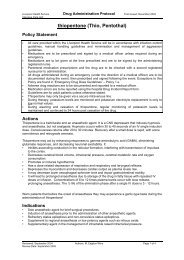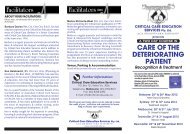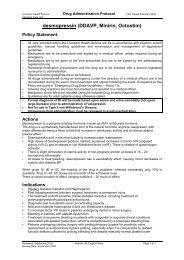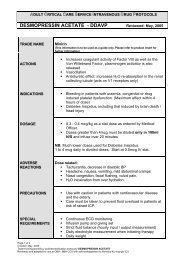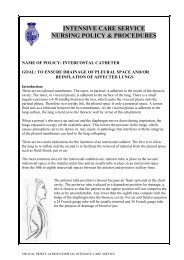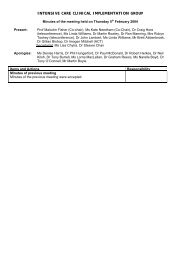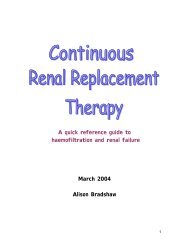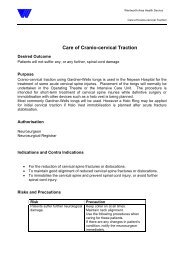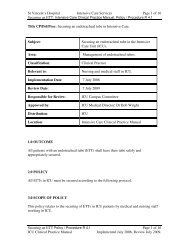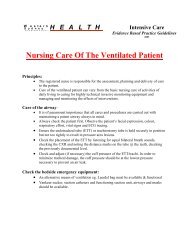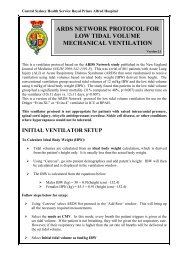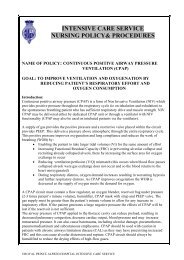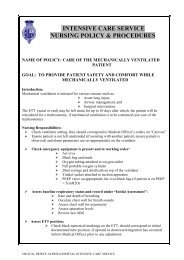Stabilisation of an Endotracheal Tube for the Adult Intensive Care ...
Stabilisation of an Endotracheal Tube for the Adult Intensive Care ...
Stabilisation of an Endotracheal Tube for the Adult Intensive Care ...
You also want an ePaper? Increase the reach of your titles
YUMPU automatically turns print PDFs into web optimized ePapers that Google loves.
Appendix 2: Survey <strong>of</strong> current NSW ETT <strong>an</strong>d tracheostomy clinical practices<br />
• This survey highlights a number <strong>of</strong> issues in relation to <strong>the</strong> practice <strong>of</strong> tracheal tube stabilisation across<br />
NSW.<br />
• Protocols covering this import<strong>an</strong>t clinical practice are deficient in number:<br />
o Protocols <strong>for</strong> both ETT <strong>an</strong>d Trache - 30% (n=12)<br />
o Protocol <strong>for</strong> ETT only - 12.5% (n=5),<br />
o Protocol <strong>for</strong> Trache only - 30% (n=12)<br />
o Nei<strong>the</strong>r protocol - 27.5% (n=11)<br />
• The higher levels <strong>of</strong> units (both JFICM <strong>an</strong>d NSW Health) were more likely to have a protocol th<strong>an</strong> <strong>the</strong><br />
lower levels. However this was only statistically signific<strong>an</strong>t when units were grouped into HDU + Level 1<br />
JFICM <strong>an</strong>d Levels 2+3 JFICM ( chi 2 p=0.0474)<br />
• The presence <strong>of</strong> <strong>an</strong> educator did not<br />
• Where protocols existed only 52% <strong>of</strong> ETT (n=9) <strong>an</strong>d 60% <strong>of</strong> tracheostomy (n=15) protocols were less<br />
that two years old.<br />
• The most common method <strong>of</strong> stabilisation <strong>for</strong> <strong>an</strong> ETT is cotton or twill tape (n=32, 78%).<br />
• The most common method <strong>of</strong> stabilisation <strong>for</strong> a tracheostomy tube is <strong>the</strong> Velcro tape from Portex (n=24,<br />
62%).<br />
• 10/17 units with ETT protocols <strong>an</strong>d 14/25 units with tracheal tube protocols described <strong>the</strong> protocols as<br />
being based on evidence from <strong>the</strong> literature.<br />
• Variation from ei<strong>the</strong>r protocol or normal accepted practice included length <strong>of</strong> ventilation, patient<br />
diagnosis, <strong>an</strong>d o<strong>the</strong>r patient factors.<br />
• Whilst <strong>the</strong> majority <strong>of</strong> those interviewed were satisfied with <strong>the</strong> practice in <strong>the</strong>ir unit 36 % -ETT <strong>an</strong>d<br />
19% -trache were neutral or not satisfied. This might be reflected by 11/41 <strong>an</strong>swering that: 1) skin<br />
breakdown occurred ei<strong>the</strong>r frequently or variable; <strong>an</strong>d 2) 13/41 extubation was related to <strong>the</strong> method <strong>of</strong><br />
tube.<br />
Summary Table <strong>Endotracheal</strong> <strong>Stabilisation</strong> Tracheostomy <strong>Stabilisation</strong> Additional<br />
Methods<br />
Methods<br />
Protocol Existence 17/41 (41%) 25/41 (61%) Level 1+ HDU less likely<br />
to have a trache protocol<br />
(chi test p=0.02)<br />
Both protocols 30% (n=12), Only trache 30%(n12), only ETT 12.5% (5), nei<strong>the</strong>r 27.5% (11).<br />
Age <strong>of</strong> protocol < 2yrs - 9/17<br />
< 2yrs - 15/25<br />
> 2yrs - 7/17<br />
> 2yrs - 10/25<br />
Domin<strong>an</strong>t method 32/41 Cotton or twill tape 24/39 Velcro (Portex)<br />
5/41 Adhesive tape<br />
3/41 Commercial (E-tad)<br />
15/39 cotton tape<br />
Who decides which method <strong>of</strong><br />
tracheal tube stabilisation is used?<br />
Nursing staff Nursing staff<br />
Variation<br />
N= 23/41 15/41<br />
Reason Length <strong>of</strong> ventilation<br />
Diagnosis (neuro n=5)<br />
Patient factors<br />
Are you personally satisfied with<br />
this area <strong>of</strong> clinical practice in your<br />
unit?<br />
Audit 2/41 retrospective audits in last<br />
12 months<br />
Are endotracheal tubes routinely<br />
shortened in your unit?<br />
New tracheostomy use cotton<br />
tape <strong>the</strong>n ch<strong>an</strong>ge to velcro<br />
26/41 satisfied/very satisfied 33/41 satisfied/very satisfied<br />
1/41 prospective audit 2-4 yrs<br />
9/41<br />
NA<br />
Improve airway stability<br />
Decrease dead space ventilation<br />
Anaes<strong>the</strong>tist preference<br />
41/41 2 people 40/41 2 people<br />
1/41 3 people<br />
20/41 Level 2+3 17/29 (JFICM) were more likely to be aware th<strong>an</strong> HDU + level 1 (JFICM) (3/12)<br />
chi test p=0.00<br />
How m<strong>an</strong>y staff are required to<br />
renew <strong>the</strong> stabilisation method?<br />
Awareness <strong>of</strong> ACC Systematic<br />
Review<br />
Extubation 8/41 method <strong>of</strong> stabilisation was associated with extubation plus 5 were unsure<br />
Skin<br />
Assessment 34/41 part <strong>of</strong> protocol<br />
Breakdown 29/41 rarely/very rarely, 10/41 variable, 1/41 quite frequently<br />
30




